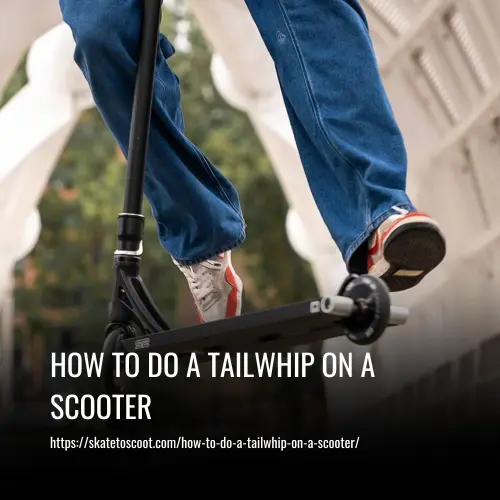As an Amazon Associate we earn from qualifying purchases.
To Do A Tailwhip On A Scooter, Follow These Steps:
- Step 1: Understand What Tailwhip Is
- Step 2: Choose The Right Scooter
- Step 3: Prepare Yourself
- Step 4: Stand On The Scooter
- Step 5: Grip The Handlebar Properly
- Step 6: Speed Up
- Step 7: Jump Up
- Step 8: Spinning The Scooter By Kicking The Deck
- Step 9: Landing
- Step 10: Keep Riding To Avoid Shakes

How To Do A Tailwhip On A Scooter: A Step-by-Step Guide
A tailwhip on a scooter is a cool and impressive maneuver that can elevate your scooter riding skills. To successfully perform a tailwhip, follow these step-by-step instructions:
Step 1: Understand What Tailwhip Is
Before attempting a tailwhip, it’s essential to comprehend what it entails. A tailwhip is a trick that involves spinning the scooter’s deck in mid-air using your feet. It can be done as a tailwhip or a heel whip. For the purposes of this guide, we’ll focus on the tailwhip.
Step 2: Choose The Right Scooter
To perform tricks like tailwhips, it’s crucial to have a scooter specifically designed for stunt riding. Look for a scooter with a durable deck, sturdy handlebars, good-quality wheels, and a lightweight frame. Choosing the right scooter will make learning and executing tricks much easier.
Step 3: Prepare Yourself
Before attempting a tailwhip, it’s important to warm up your body and get in the right mindset. Stretch and do some light exercises to loosen up your muscles. Additionally, wearing proper protective gear, including a helmet and pads, is essential to stay safe while practicing and performing tailwhips.
Step 4: Stand On The Scooter
Once you’re warmed up and protected, stand on the scooter with your feet in a comfortable position. Be sure to position yourself slightly backward on the scooter to have better control and leverage when kicking and spinning the scooter.
Step 5: Grip The Handlebar Properly
Maintaining a proper grip on the handlebar is crucial for a successful tailwhip. Hold the handlebar firmly with both hands and wrap your fingers around it. This grip will help provide stability and control as you kick the scooter.
Step 6: Speed Up
To execute a tailwhip effectively, you need to build up a moderate amount of speed. Push down on the deck with your feet to generate momentum and maintain stability. Remember to keep your feet and legs locked onto the deck and the handlebar steady.
Step 7: Jump Up
As you reach the take-off point, crouch low and use your calves and ankles to jump up while keeping your feet locked onto the deck. Focus on jumping straight up initially, and as you become more advanced, you can experiment with different jumping variations.
Step 8: Spinning The Scooter By Kicking The Deck
While in mid-air, kick the tail end of the deck with your back foot to initiate the spin. Use your arms to help balance yourself and keep the handlebar steady. Practice this motion on the ground before attempting it in the air for the first time.
Step 9: Landing
As you descend, visually track your scooter’s deck and aim to land with both feet securely on it. Maintain proper body alignment and balance to achieve a smooth landing. Be conscious of your center of gravity and adapt to the scooter’s movements in the air.
Step 10: Keep Riding To Avoid Shakes
After successfully landing a tailwhip, keep riding to maintain your flow and avoid any wobbles or shakes. Focus on keeping your legs bent and locked to maintain balance. With plenty of practice and dedication, you can master the tailwhip and become an impressive freestyle scooter rider.
How To Tailwhip On A Scooter Flat
To do a tailwhip on a scooter flat, start by positioning your feet in a wide stance on the scooter, with your non-dominant foot towards the back. Lean back and pull up on the handlebars, shifting your weight towards the back foot. As you reach the top of the arc, place your dominant foot on the deck and push off with your non-dominant foot.
The momentum of the arc will cause the scooter to spin around and complete a full tailwhip. Practice is essential to perfecting this trick, so start with a moderate speed and gradually increase it as you become more comfortable. Remember to maintain a circular motion and keep your body centered for a smooth landing.
How To Do A 360 Tailwhip On A Scooter
To do a 360 tailwhip on a scooter, start by pushing off from the ground and gaining moderate speed. Position your left foot on the scooter deck and your right foot slightly behind. As you approach the takeoff point, shift your weight towards the rear wheel and prepare for the trick.
Using your upper body and a circular motion, swing the scooter deck in a complete rotation around your body, throwing it up and over your head. Simultaneously, kick your legs in the opposite direction to initiate the tailwhip. Keep your eyes on the scooter throughout the rotation and spot your landing.
As the scooter completes the 360-degree spin, catch it with your left foot and bring it back to its original position. Practice and repetition are key to mastering this trick, so be prepared to put in the time and effort to achieve a smooth landing.
How Long Does It Take to Learn a Tailwhip on a Scooter
Learning a tailwhip on a scooter takes time, patience, and practice. It is recommended to have the right type of scooter, such as a stunt scooter, before attempting this trick. It is essential to become comfortable with basic airs and manuals first. Once these skills are mastered, riders can start working on whipping the back end of their scooter around.
It is important to practice in an area with soft landings in case of falls. Starting with small hops and gradually increasing height will help build up to performing the full trick. It is important to remember that learning a tailwhip takes time, so do not get discouraged if it does not come immediately.
How Hard is a Tailwhip on a Scooter
A tailwhip on a scooter may seem difficult, but with enough practice, it can be mastered. The key is to start at a moderate speed that allows for control and balance. By popping the scooter up into the air while keeping one foot on the front of the deck, you can swing your back leg in a complete circle, causing the scooter to spin around and land on its tail end.
Start with slow and controlled movements until you feel comfortable before adding more speed or height to your jumps. With dedication and perseverance, you can perfect this impressive maneuver and wow your friends.
Common Mistakes to Avoid
Here are Some Common Mistakes to Avoid When Doing a Tailwhip on a Scooter.
1. Not scooping hard enough with your back foot
One of the most common mistakes when attempting a tailwhip is not generating enough force with your back foot. To execute a tailwhip, you need to scoop the back end of the scooter with your foot, causing it to rotate in mid-air. Failing to do this forcefully enough can result in an incomplete rotation or a wobbly landing.
2. Starting rotation too late or too early
Timing is crucial when performing a tailwhip. If you start rotating too early, the scooter may spin before you have a chance to jump, leading to an awkward landing. On the other hand, starting the rotation too late can result in an incomplete or slow spin. Practice timing your jump and foot motion to achieve a smooth and fluid tailwhip.
3. Forgetting about balance and control during execution
It’s easy to get caught up in the excitement of performing a tailwhip trick, but it’s important not to neglect your balance and control. Maintain a strong and stable posture, keeping your core engaged and your eyes focused on a spot in front of you. This will help you stay balanced throughout the trick and land smoothly.
Remember, performing a tailwhip on a scooter requires plenty of practice and commitment. By avoiding these common mistakes and focusing on proper technique, you’ll be on your way to mastering this impressive maneuver.
Tips For Tailwhip on a Scooter
To successfully execute a tailwhip on a scooter, there are several key tips you should keep in mind:
1. Practice Step by Step
Breaking down the tailwhip into smaller components can help you understand and master each motion. Start by scooping the back end of the scooter with your foot, gradually increasing the force until you can generate enough rotation. Once you’re comfortable with the motion, combine it with the jump and landing.
2. Timing is Everything
Getting the timing right is crucial for a smooth tailwhip. Make sure you jump at the right moment, just as you start to scoop the scooter. This will allow you to rotate in mid-air and land properly. Timing comes with practice, so be patient and keep trying until you find the right rhythm.
3. Focus on Balance and Control
Throughout the tailwhip, it’s important to maintain proper balance and control. Keep your core engaged and your eyes fixed on the scooter for better stability. Avoid leaning too far forward or backward, as this can affect your landing. Stay centered and in control throughout the trick.
4. Start with Small Bunny Hops
When starting out, it’s best to use small bunny hops instead of jumping too high. This will give you enough air time to rotate the scooter while still maintaining control. As you become more confident, you can gradually increase the height of your jumps.
Safety Precautions
Stunt scootering is an exhilarating sport that offers riders the opportunity to perform impressive tricks and maneuvers. However, it is essential to prioritize safety when attempting these tricks to avoid potential injuries. By following these safety precautions, riders can minimize the risks associated with stunt scootering:
1. Wear Protective Gear
Always wear a helmet, knee pads, and elbow pads to protect yourself from potential injuries. These protective gears enhance your safety and provide cushioning during falls or crashes.
2. Choose the Right Location
Practice your scooter tricks on a smooth, flat surface free from obstacles or hazards. Avoid locations with heavy traffic or uneven terrain.
3. Know Your Limits
Before attempting any trick, ensure that you have mastered the necessary skills and have acquired sufficient experience with basic scooter riding. You should only perform tricks within your skill level and gradually progress to more advanced maneuvers.
4. Warm Up and Stretch
Begin your practice sessions with a warm-up routine to loosen your muscles and increase blood circulation. Stretching exercises help improve flexibility and reduce the risk of muscle strains or pulls.
5. Practice with a Spotter
If possible, have a friend or experienced rider act as a spotter to assist you during trick attempts. They can provide guidance, lend a helping hand, and ensure your safety while practicing new or challenging maneuvers.
6. Know Your Scooter
Regularly inspect your scooter for any loose or damaged parts. Ensure that the handlebars, brakes, and wheels are properly maintained and functioning correctly.
FAQs
To perform a tailwhip on a scooter, you will need a sturdy scooter deck that can withstand the impact of the trick. It is recommended to use a stunt scooter with a strong rear wheel for better stability.
To prevent your scooter from breaking, ensure that you have the correct foot placement. Keep your left foot firmly on the deck and place your right foot slightly off the scooter, ready to whip the deck around. Additionally, practice landing with both feet and distribute your weight evenly to avoid putting excessive pressure on the scooter deck.
It is possible to do a tailwhip on most smooth surfaces. However, it is important to consider any surface irregularities, as they may impact the stability and landing of your tailwhip. Always prioritize safety and choose surfaces conducive to performing tricks.
The time it takes to learn a tailwhip varies from person to person. Some riders may learn it quickly with practice, while others may require more time. Consistent dedication and plenty of practice are key factors in learning and mastering this trick.
To improve your tailwhip, start by practicing at a moderate speed to gain better control and stability. Focus on the proper technique of the trick, which involves a complete rotation of the scooter deck in a circular motion. Engage your upper body to generate the necessary momentum and rotation in time with your foot movement.
When performed correctly and with proper technique, a tailwhip should not cause any significant damage to the scooter. However, if executed improperly or on unsuitable surfaces, excessive force may be applied to the scooter deck, causing it to weaken or break over time.
Performing a tailwhip on a Razor scooter follows the same principles as any other scooter. Ensure you have a strong scooter deck and rear wheel. Practice the foot positioning and movement necessary for the tailwhip, implementing the tips mentioned earlier. Adapt your technique to the specific features and dimensions of your Razor scooter.
If you are having difficulty performing a tailwhip on a scooter, it could be due to various factors such as lack of practice, improper technique, incorrect foot placement, or using a scooter that may not be suitable for performing advanced tricks. Engaging in consistent practice and seeking guidance from experienced riders can help you overcome these challenges.
Conclusion
In conclusion, mastering the tailwhip on a scooter is no easy feat, but with the right technique, dedication, and practice, anyone can learn this impressive trick. Remember to start with the basic tricks and gradually progress to more advanced maneuvers. Focus on your foot placement, using your left foot to initiate the tailwhip motion and ensuring that you have enough air time for a complete rotation.
Maintain a moderate speed and a wide circular path to execute a smooth and controlled tailwhip. Keep your upper body stable and centered, and use your handlebars to maintain balance throughout the trick. With perseverance and determination, you can achieve a perfect tailwhip and become a skilled freestyle scooter rider.
Amazon and the Amazon logo are trademarks of Amazon.com, Inc, or its affiliates.



